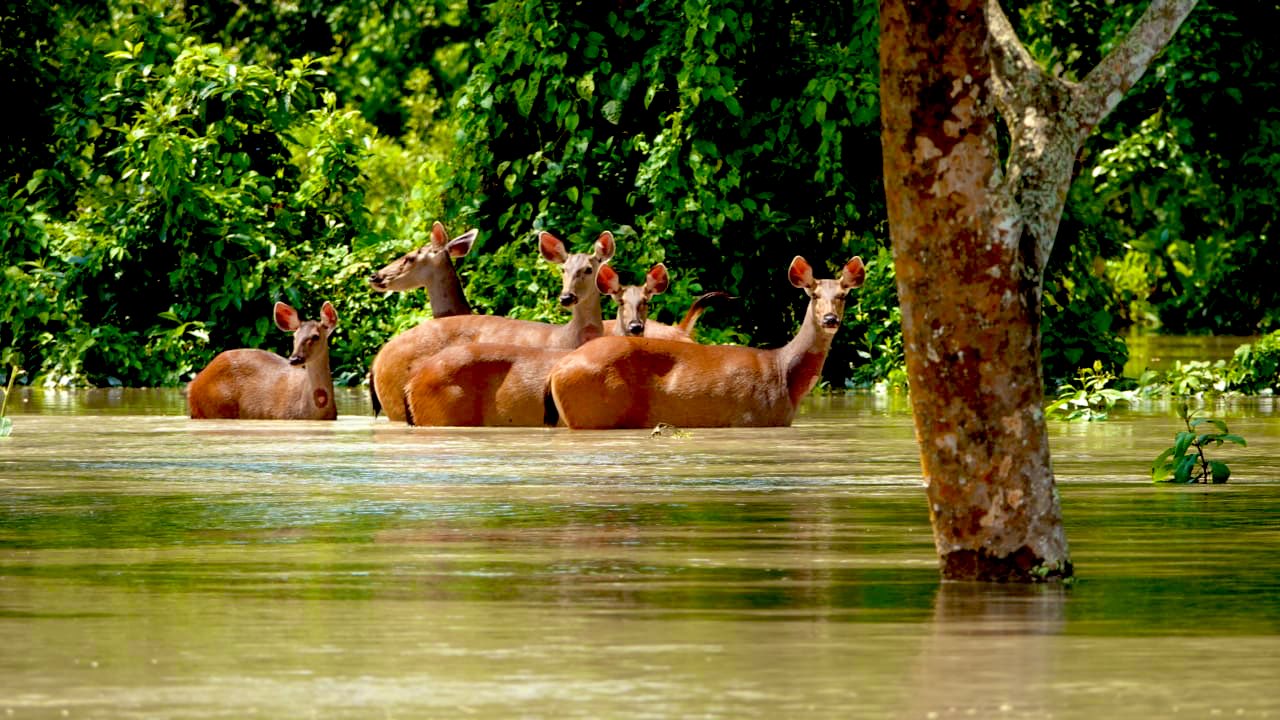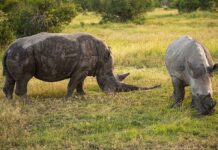The whole country is presently grappling with the coronavirus pandemic and as nation-states across the country work towards reducing the impact of the deadly virus and saving human lives amid limited medical infrastructure and a heavy case load, the state of Assam has been faced with another equally important and life-threatening challenge.
The state of Assam is experiencing heavy flooding and almost all of its thirteen rivers and tributaries have been flowing well above the danger mark.
The worsening of the flood situation has recked havoc on the people of the state who were already facing growing cases of coronavirus and multiplied their hardships and difficulties. While NDRF teams work to rescue people and take them to safer locations in all the affected districts and the state authorities work towards easing out their worries for ration and medical supply, one of the worst affected from the flood are the animals of the Kaziranga National Park.

The Kaziranga National Park is a very well-known national park and a UNESCO World Heritage Site. The Kaziranga National Park boasts of a large number of animals and birds that are rare, esoteric and cherished by nature and wildlife lovers from across the world. The national park is however the most famous for species such as the one-horned rhinoceros among a host of others. The extensive flooding in the region has already led to the deaths of more than 51 wild animals and over 100 have been rescued so far.
It has been reported that while a large number of animals could be rescued, it is feared that hundreds of others may have succumbed in the floods, gone astray or may even have fallen prey to poaching. The situation at the national park is quite serious because the 430 square kilometre campus is now witnessing more than 95% of its land submerged by the floods and the nearby National Highway-37 has also been severely affected by the incessant rains and floods.
A female rhino calf was separated from her mother due to high flood in the Agartoli range yesterday. As we could not locate the mother, team CWRC along with @kaziranga_ staffs rescued it and currently under care at our rescue centre-CWRC. @ParimalSuklaba1 @wti_org_India pic.twitter.com/LLPHrDPQ8Z
— Kaziranga National Park & Tiger Reserve (@kaziranga_) July 15, 2020
This year, the floods in the state of Assam are amongst the most destructive in the last couple of years and heavy rainfall and flooding has impacted 27 of Assam’s 33 districts. Ground reports remind us that the intensity of the floods is such that over 22 lakh people have been severely affected by it. Wide ranging crop lands, people’s homes and agricultural produce, farm animals and public infrastructures have been impacted adversely due to the floods. It has been estimated that some 2,816 villages are among the worst affected and nearly one lakh hectares of land on which crops were sown have been lost due to excessive flooding. From roads and bridges, embankments and buildings, the Assam floods have indeed recked havoc for the state as a whole amid the coronavirus pandemic.

It is in this context that CM Sarbananda Sonowal has asked MLAs and MPs to get into immediate relief work and execute relief operations to help out the people. The worst affected district in the state is Barpeta and here more than five lakh people have been affected. Thanks to the efforts of the NDRF teams, rescue operations are now continuing in full swing in Assam.
The Kaziranga National Park is a very well-known UNESCO World Heritage Site(it was declared a site by the UNESCO in 1985). Official estimates suggest that the park boasts of over 2,200 one-horned rhinoceros and this is approximately two-third of the entire population in the world.
The park is known for its extensive biodiversity and its ability to attract animal lovers and wildlife conservationists from around the world. But every year, the problem of flooding has emerged as a big challenge for the animal population living at the national park. Excessive flooding in the jungles has often been responsible for forcing these animals to venture into nearby villages and towns, thereby causing a threat to villagers and residents on the outskirts of the national park.
One year old rhino was rescued near Sukani camp, Agartoli range. Our Vet @samshulwildvet has led the team. Kudos 👏👏👏. @ParimalSuklaba1 @wti_org_india @vivek4wild @SaikiaRohini @rathinbarman @iam_Pirai @ritupabanborah pic.twitter.com/X4FuhjroNY
— Kaziranga National Park & Tiger Reserve (@kaziranga_) July 14, 2020
The floods lead to the injury of a large number of animals and make them vulnerable to losing their lives. Although floods are almost an annual occurrence in Assam, their impact and destructive forces have time and again erected several challenges for protecting the lives of the animal inhabitants of the Kaziranga National Park in addition to lakhs of people whose lives stand toppled and destroyed amid the floods.













